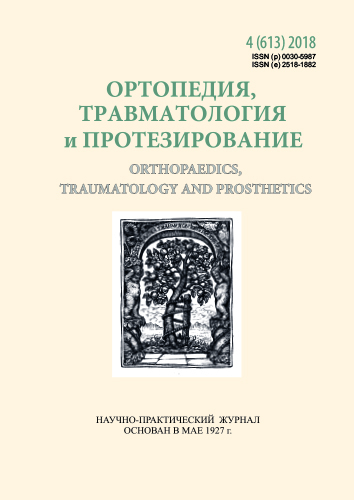Bilateral hip joint arthroplasty in dysplastic hip arthritis in patients with osteopenia and osteoporosis
DOI:
https://doi.org/10.15674/0030-59872018458-63Keywords:
dysplastic hip arthritis, bilateral hip arthroplasty, osteopenia and osteoporosisAbstract
In severe forms of dysplastic hip arthritis (DA) total hip arthroplasty is the most effective method of treatment. Objective: to investigate the results of bilateral hip arthroplasty in patients with dysplastic hip arthritis combined with osteopenia and osteoporosis. Methods: we examined 72 women with DA after bilateral total hip. The main group included 45 patients, who had DA combined with signs of osteopenia and osteoporosis. The control group consisted of 27 patients without signs of decreased mineral bone density. The mean age of patients in the main group was (51.5 ± 2.06) years, in the control group — (43.5 ± 2.25) years. Before surgery we assessed indexes: cortical, Singh, morpho-cortical, Noble, Spotorno. We analyzed the type of the femoral canal according to Spotorno and Dorr, type of dysplastic acetabulum. Results: 90 surgeries were made in the main group of patients, of which in 86 cases (95.6 %) cementless implants were used, in 3 cases (3.3 %) — hybrid fixation, in 1 case (1.1 %) — reverse hybrid fixation was used. The patients of the control group were undergone 54 operations of cementless hip replacement. The average evaluation
of the results of treatment according to Harris hip score was 88.2 in the main group, in the control group — 89.1 points. Conclusions: during the planning of hip arthroplasty in patients with bilateral DA, it is necessary to take into account the x-ray anthropometric characteristics of the proximal femur, which allow to choose the design of the femoral component of the endoprosthesis and the type of its fixation, depending on the two-plane
shape of the medullary canal. The use of threaded cementless cups allow to achieve a primary stable fixation of the acetabular component of the endoprosthesis in case of dysplastic deformation of the acetabulum even at decreased bone density.
References
- Anisimova, E. A., Yusupov, K. S., & Anisimov, D. I. (2014). Morphology of bone structures of the hip joint in norm and with dysplastic coxarthrosis. Saratov Journal of Medical Scientific Research, 10 (3), 373–377. (in Russian)
- Loskutov, A. E., & Sinegubov, D. A. (2008). Bilateral hip joint replacement. Dnepropetrovsk, Porohy. (in Ukraine)
- Poluliakh, M. V., Gerasimenko, S. I., Kostyuk, A. N., Poluliakh, D. M., Babko, A. M., Gerasimenko, A. S., & Gromadsky, V. M. (2014). Features of hip joint replacement in severe forms of dysplasia. Trauma, 15 (5), 33–36. (in Ukraine)
- Tikhilov, R. M., & Shubnyakov, I. I. (eds.) (2015). Manual on hip surgery (ІІ). St. Petersburg: RNIITO named after R. R. Vreden. (in Russian)
- Loskutov, A. E. (2010). Hip joint replacement: monograph. Dnepropetrovsk: LIRA. (in Ukraine)
- Koryak, V. A., Sorokovikov, V. A., Svistunov, V. V., & Sharova, Т. V. (2013). Epidemiology of coxarthrosis. Siberian Medical Journal, 8, 39–45. (in Russian)
- Bultink, I. E., & Lems, W. F. (2013). Osteoarthritis and osteoporosis: what is the overlap? Current Rheumatology Reports, 15 (5), 328. doi:https://doi.org/10.1007/s11926-013-0328-0
- Greber, E. M., Pelt, C. E., Gililland, J. M., Anderson, M. B., Erickson, J. A., & Peters, C. L. (2017). Challenges in total hip arthroplasty in the setting of developmental dysplasia of the hip. The Journal of Arthroplasty, 32 (9), S38–S44. doi:https://doi.org/10.1016/j.arth.2017.02.024
- Rizou, S., Chronopoulos, E., Ballas, M., Lyritis, G. P. (2018). Clinical manifestations of osteoarthritis in osteoporotic and osteopenic postmenopausal women. Journal of Musculoskeletal and Neuronal Interactionst, 18 (2), 208–214.
- Bicanic, G. (2014). Current concept in dysplastic hip arthroplasty: Techniques for acetabular and femoral reconstruction. World Journal of Orthopedics, 5 (4), 412. doi:https://doi.org/10.5312/wjo.v5.i4.412
- Gustke, K. (2013). The dysplastic hip. The Bone & Joint Journal, 95-B (11_Supple_A), 31–36. doi:https://doi.org/10.1302/0301-620x.95b11.32899
- Lawrence, R. C., Helmick, C. G., Arnett, F. C., Deyo, R. A., Felson, D. T., Giannini, E. H., … Wolfe, F. (1998). Estimates of the prevalence of arthritis and selected musculoskeletal disorders in the United States. Arthritis & Rheumatism, 41 (5), 778–799. doi:https://doi.org/10.1002/1529-0131(199805)41:5<778::aid-art4>3.0.co;2-v
- Lakstein, D., Tan, Z., Oren, N., Mаkinen, T. J., Gross, A. E., & Safir, O. (2017). Preoperative planning of total hip arthroplasty on dysplastic acetabuli. Hip International, 27 (1), 55–59. doi: https://doi.org/10.5301/hipint.5000419
- Schiessel, A., Brenner, M., & Zweymuller. K. (2005). Bilateral hip joint replacement as a one-stage or two-stage procedure for dysplastic coxarthritis: a comparative analysis of 30 patients. Z. Orthop Ihre Grenzgeb, 143 (6), 616–21. doi: https://doi.org/10.1055/s-2005-918185
Downloads
How to Cite
Issue
Section
License
Copyright (c) 2019 Oleksandr Loskutov, Oleg Loskutov, Dmytro Syniehubov

This work is licensed under a Creative Commons Attribution 4.0 International License.
The authors retain the right of authorship of their manuscript and pass the journal the right of the first publication of this article, which automatically become available from the date of publication under the terms of Creative Commons Attribution License, which allows others to freely distribute the published manuscript with mandatory linking to authors of the original research and the first publication of this one in this journal.
Authors have the right to enter into a separate supplemental agreement on the additional non-exclusive distribution of manuscript in the form in which it was published by the journal (i.e. to put work in electronic storage of an institution or publish as a part of the book) while maintaining the reference to the first publication of the manuscript in this journal.
The editorial policy of the journal allows authors and encourages manuscript accommodation online (i.e. in storage of an institution or on the personal websites) as before submission of the manuscript to the editorial office, and during its editorial processing because it contributes to productive scientific discussion and positively affects the efficiency and dynamics of the published manuscript citation (see The Effect of Open Access).














